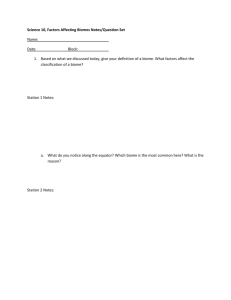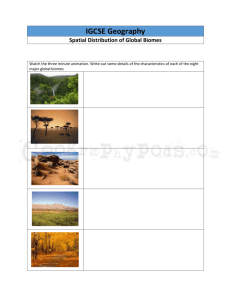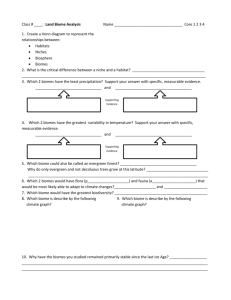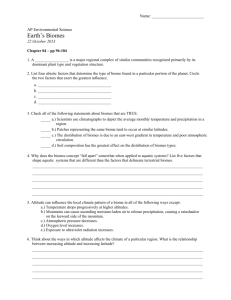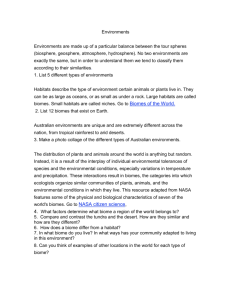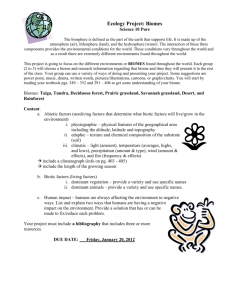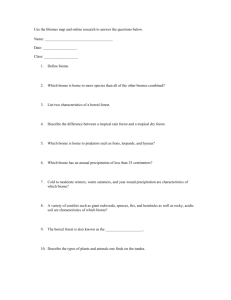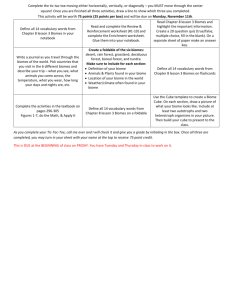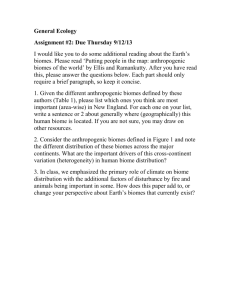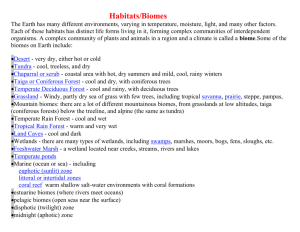biome project – science 8 – ms ainsworth
advertisement
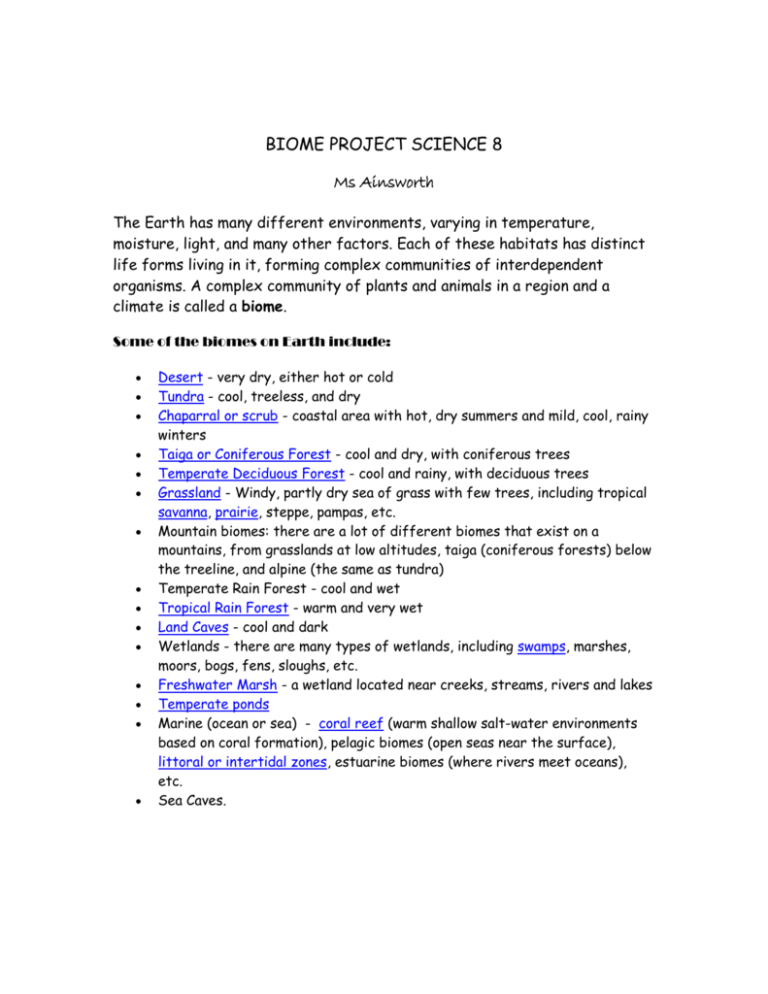
BIOME PROJECT SCIENCE 8 Ms Ainsworth The Earth has many different environments, varying in temperature, moisture, light, and many other factors. Each of these habitats has distinct life forms living in it, forming complex communities of interdependent organisms. A complex community of plants and animals in a region and a climate is called a biome. Some of the biomes on Earth include: Desert - very dry, either hot or cold Tundra - cool, treeless, and dry Chaparral or scrub - coastal area with hot, dry summers and mild, cool, rainy winters Taiga or Coniferous Forest - cool and dry, with coniferous trees Temperate Deciduous Forest - cool and rainy, with deciduous trees Grassland - Windy, partly dry sea of grass with few trees, including tropical savanna, prairie, steppe, pampas, etc. Mountain biomes: there are a lot of different biomes that exist on a mountains, from grasslands at low altitudes, taiga (coniferous forests) below the treeline, and alpine (the same as tundra) Temperate Rain Forest - cool and wet Tropical Rain Forest - warm and very wet Land Caves - cool and dark Wetlands - there are many types of wetlands, including swamps, marshes, moors, bogs, fens, sloughs, etc. Freshwater Marsh - a wetland located near creeks, streams, rivers and lakes Temperate ponds Marine (ocean or sea) - coral reef (warm shallow salt-water environments based on coral formation), pelagic biomes (open seas near the surface), littoral or intertidal zones, estuarine biomes (where rivers meet oceans), etc. Sea Caves. Biome Project Your project must include text and pictures. (cut and pasted pictures must have a cited source). Your poster must include the following: Biome name Labeled map illustrating biome location(s) around the world Climate Ecological concerns Conservation efforts Animals Plants Your perspective 1. You may work with a partner (your work will need to be twice as good!). 2. Each partnership will do a different Biome; so confirm your choice with Ms Ainsworth before you begin. 3. You will need to do the computer part of your research outside of classroom time, as computer space is limited. You will have access to written materials from the library. 4. You must have a group poster and each person in the group must hand in a package of written material. Your package must include… These instruction sheets (x4) Your research notes and keyword notes Your completed self/peer evaluation sheet A formal bibliography YOUR PROJECT IS DUE ON MONDAY MAY 17TH. BIOME PROJECT – SCIENCE 8 – MS AINSWORTH Self/Peer Evaluation Name/s of group members _____________________________________ Title of your Project ________________________________________ How did your group work together? _______________________________________ What part of the assignment were you responsible for? ___________________ Did all of the group members work equally on the assignments? ________ What was the best part of this assignment? ______________________________ What was your least favourite part of this assignment? __________________ SITES TO LOOK AT This school site has each of the biomes listed so that you can link to them directly… http://sd71.bc.ca/sd71/school/courtmid/Library/index.htm You can also look in… www.enchantedlearning.com http://www.bbc.co.uk/ http://www.bbc.co.uk/gcsebitesize http://www.ucmp.berkeley.edu/glossary/gloss5/biome/ http://www.worldbiomes.com/ http://www.blueplanetbiomes.org/world_biomes.htm If you need help with your bibliography go to…. http://www.landmarkproject.com/citation_machine/index.php?mode=form&list=nonprint&cm =9 CMS Note-Taking Form Name: Division: IMPORTANT: While reading the resource, you will not be taking notes…you will be writing keywords and copying a few important quotations. Directly after reading a section of the resource and writing keywords, you may then use the keywords to write paragraphs (without looking back at the original resource). Quotations: Be sure to include the page number. (p. 43) Resource information (in one of the formats below): Keywords Book: Author last name, First name or initial. (date of publication). Title of publicatio Location of Publication: Publisher. Web resource: Author last name, First name or initial. (date of publication). Title of publicatio or Web site. Location of Publication: Publisher. [Online] Available: http://…. (Visited on October…) Your Paragraphs
